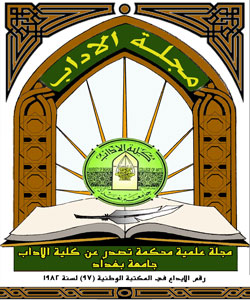The Acquisition of /r/ in Iraqi Arabic
DOI:
https://doi.org/10.31973/aj.v1i143.3895الكلمات المفتاحية:
sound acquisition، Iraqi Arabic، cross dialectal variationالملخص
There is very little research in the field of Arabic language acquisition This study explores the development in the acquisition of the trill /r/ in Iraqi Arabic (IA). It attempts to answer four main questions: (1) What percentage in the total sample produced /r/ correctly? (2) Is this the age of customary, acquisition, or mastery for IA children? (3) Does the production accuracy of /r/ vary by position in the syllable and child sex? (4) How is the acquisition of /r/ developed within this age group? Samples were collected from 20 normally developing children between the ages of 1:8 and 3:7. The results showed noticeable sex differences in the acquisition of /r/. Besides, /r/ was produced more accurately in syllable-initial than syllable-final position. Statistics reflected a cross-dialectal variation among Arabic dialects, where Iraqi children acquired /r/ at different age it is acquired in other Arabic dialects, such as Jordanian Arabic. However, results of this paper go in support of previously suggested universal sound acquisition as /r/ was acquired in IA at about the same age it is acquired in English. The acquisition of /r/ was accompanied by gliding and deletion.
التنزيلات
المراجع
Al-Ani, S. (1970). Arabic phonology. The Hague: Mouton.
Amayreh, M. (1994). A normative study of the acquisition of consonant sounds in Arabic (Doctoral dissertation, University of Florida, 1994). Dissertation Abstracts International, 56-11, 6065.
Amayreh, M.& Dyson, A. (1998). The Acquisition of Arabic Consonants. Journal of Speech, Language, and Hearing Research 41, 642–653.
Amayreh, M. & Dyson, A. (2000). Phonetic Inventories of young Arabic- speaking children. Clinical Linguistics & phonetics. VOL. 14, NO. 3,193-215.
Ammar, W., & Morsi, R. (2006). Phonological Development and Disorder:
Colloquial Egyptian Arabic. In Z. Hua (Ed.), Phonological Development and Disorders in Children. (pp. 204-232). GBR: Multilingual Matters Limited.
Arlt, P. B., & Goodban, M. J. (1976). A comparative study of articulation acquisition as based on a study of 240 normals, aged three to six. Language, Speech, and Hearing Services in Schools, 7, 173–180.
Dyson, A. T., & Paden, E. P. (1983). Some phonological acquisition strategies used by two-year-olds. Journal of Childhood Communication Disorders, 7, 6–18.
Demuth, K. & Fee, E. (1995). Minimal prosodic words in early phonological development. Unpublished manuscript, Brown University, Providence, RI and Dalhousie University, Halifax, Canada.
Faraj, A. (1988). Language acquisition and development in infants. Early Child
Development and Care, 39(1), 21-31.
Feghali, H. (2008). The Dialects of Kuwait, Bahrain, Qatar, UAE, and Oman: Grammar, Dialogues, and Lexicon. USA. Dunwoody Press.
Grunwell, P. (1982). Clinical phonology. London & Canberra: Croon Helm.
Irwin, J., & Wong, S. (1983). Phonological development in children: 18 to 72 months. Carbondale, IL: Southern Illinois University Press. Kaye, A. S. (1990). Arabic. In B. Comrie (Ed.), The world’s major languages (pp. 664–685). New York: Oxford University Press
Omar, M. (1973). The acquisition of Egyptian Arabic as a native language. Janua linguarum. Series practical, 160,199–205.
Prather, E., Hedrick, D., & Kern, C. A. (1975). Articulation development in children aged two to four years. Journal of Speech and Hearing Disorders, 40,179–191(cited in Amayreh & Dyson 1998).
Templin, M. (1957). Certain language skills in children: Their development and interrelationships. Minneapolis: University of Minnesota Press. (cited in Amayreh & Dyson 1998).
Ravid, D., & Hayek, L. (2003). Learning about different ways of expressing number in the development of Palestinian Arabic. First Language, 23, 41-63
Zamunert, T. (2004). Phonotactic probabilities in young children’s speech production. University of Nijmegen. Cambridge. CUP.
التنزيلات
منشور
إصدار
القسم
الرخصة
:حقوق الطبع والنشر والترخيص
بالنسبة لجميع البحوث المنشورة في مجلة الآداب، يحتفظ الباحثون بحقوق النشر. يتم ترخيص البحوث بموجب ترخيص Creative Commons CC BY 4.0 المفتوح ، مما يعني أنه يجوز لأي شخص تنزيل البحث وقراءته مجانًا. بالإضافة إلى ذلك ، يجوز إعادة استخدام البحث واقتباسه شريطة أن يتم الاستشهاد المصدر المنشور الأصلي. تتيح هذه الشروط الاستخدام الأقصى لعمل الباحث وعرضه.
:إعادة إنتاج البحوث المنشورة من الناشرين الآخرين
من الضروري للغاية أن يحصل الباحثون على إذن لإعادة إنتاج أي بحث منشورة (أشكال أو مخططات أو جداول أو أي مقتطفات من نص) لا يدخل في نطاق الملكية العامة أو لا يملكون حقوق نشرها. يجب أن يطلب الباحثون إذنًا من مؤلف حقوق النشر (عادة ما يكون الناشر).
يطلب الإذن في الحالات التالية:
بحوثك الخاصة المنشورة من قِبل ناشرين آخرين ولم تحتفظ بحقوق النشر الخاصة بها.
مقتطفات كبيرة من بحوث أي شخص أو سلسلة من البحوث المنشورة.
استخدم الجداول والرسوم البيانية والمخططات والمخططات والأعمال الفنية إذا لم يتم التعديل عليها.
الصور الفوتوغرافية التي لا تملك حقوق لنشرها.
لا يطلب الإذن في الحالات التالية:
إعادة بناء الجدول الخاص بك مع البيانات المنشورة بالفعل في مكان آخر. يرجى ملاحظة أنه في هذه الحالة يجب عليك ذكر مصدر البيانات في شكل "بيانات من ..." أو "مقتبس من ...".
تعتبر عروض الأسعار القصيرة معقولة الاستخدام العادل ، وبالتالي لا تتطلب إذنًا.
الرسوم البيانية ، الرسوم البيانية ، المخططات ، الأعمال الفنية التي أعاد الباحث رسمها بالكامل والتي تم تغييرها بشكل ملحوظ إلى درجة لا تتطلب الاعتراف.
الحصول على إذن
لتجنب التأخير غير الضروري في عملية النشر ، يجب أن تبدأ في الحصول على أذونات في أقرب وقت ممكن. لا يمكن لمجلة الآداب نشر بحث مقتبس من منشورات أخرى دون إذن.
قد يمنحك مالك حقوق الطبع والنشر تعليمات بشأن شكل الإقرار الواجب اتباعه لتوثيق عمله ؛ بخلاف ذلك ، اتبع النمط: "مستنسخ بإذن من [المؤلف] ، [كتاب / المجلة] ؛ نشره [الناشر] ، [السنة]." في نهاية شرح الجدول ، الشكل أو المخطط.
.jpg)
























